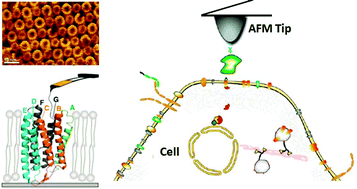Our official English website, www.x-mol.net, welcomes your feedback! (Note: you will need to create a separate account there.)
Nanoscale imaging and force probing of biomolecular systems using atomic force microscopy: from single molecules to living cells
Nanoscale ( IF 6.7 ) Pub Date : 2017-10-25 00:00:00 , DOI: 10.1039/c7nr07023c Mi Li 1, 2, 3, 4, 5 , Dan Dang 4, 5, 6, 7 , Ning Xi 1, 2, 3, 4, 5 , Yuechao Wang 1, 2, 3, 4, 5 , Lianqing Liu 1, 2, 3, 4, 5
Nanoscale ( IF 6.7 ) Pub Date : 2017-10-25 00:00:00 , DOI: 10.1039/c7nr07023c Mi Li 1, 2, 3, 4, 5 , Dan Dang 4, 5, 6, 7 , Ning Xi 1, 2, 3, 4, 5 , Yuechao Wang 1, 2, 3, 4, 5 , Lianqing Liu 1, 2, 3, 4, 5
Affiliation

|
Due to the lack of adequate tools for observation, native molecular behaviors at the nanoscale have been poorly understood. The advent of atomic force microscopy (AFM) provides an exciting instrument for investigating physiological processes on individual living cells with molecular resolution, which attracts the attention of worldwide researchers. In the past few decades, AFM has been widely utilized to investigate molecular activities on diverse biological interfaces, and the performances and functions of AFM have also been continuously improved, greatly improving our understanding of the behaviors of single molecules in action and demonstrating the important role of AFM in addressing biological issues with unprecedented spatiotemporal resolution. In this article, we review the related techniques and recent progress about applying AFM to characterize biomolecular systems in situ from single molecules to living cells. The challenges and future directions are also discussed.
中文翻译:

使用原子力显微镜对生物分子系统进行纳米级成像和力探测:从单分子到活细胞
由于缺乏足够的观察工具,人们对纳米级的天然分子行为知之甚少。原子力显微镜(AFM)的出现提供了一种令人兴奋的工具,能够以分子分辨率研究单个活细胞的生理过程,引起了全世界研究人员的关注。在过去的几十年中,原子力显微镜已广泛用于研究分子在各种生物界面上的活性,原子力显微镜的性能和功能也得到了不断改进,极大地增进了我们对单个分子在行为上的行为的了解,并证明了其重要作用。 AFM以前所未有的时空分辨率解决生物问题。在本文中,从单分子到活细胞的原位。还讨论了挑战和未来方向。
更新日期:2017-11-23
中文翻译:

使用原子力显微镜对生物分子系统进行纳米级成像和力探测:从单分子到活细胞
由于缺乏足够的观察工具,人们对纳米级的天然分子行为知之甚少。原子力显微镜(AFM)的出现提供了一种令人兴奋的工具,能够以分子分辨率研究单个活细胞的生理过程,引起了全世界研究人员的关注。在过去的几十年中,原子力显微镜已广泛用于研究分子在各种生物界面上的活性,原子力显微镜的性能和功能也得到了不断改进,极大地增进了我们对单个分子在行为上的行为的了解,并证明了其重要作用。 AFM以前所未有的时空分辨率解决生物问题。在本文中,从单分子到活细胞的原位。还讨论了挑战和未来方向。



























 京公网安备 11010802027423号
京公网安备 11010802027423号